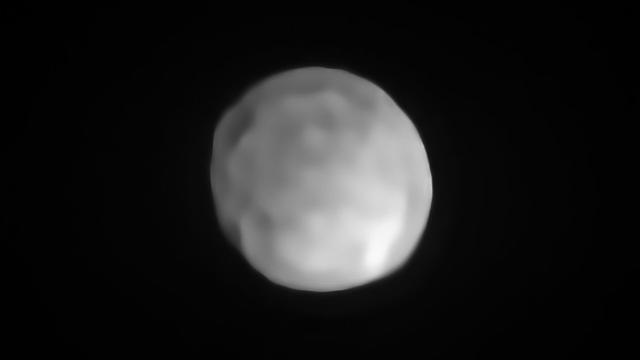A new telescopic survey of Hygiea”the fourth largest object in the main asteroid belt”suggests it’s a dwarf planet, due to its surprisingly spherical shape.
Discovered in 1849 by Italian astronomer Annibale de Gasparis, Hygiea is located in the main asteroid belt between Mars and Jupiter. It’s the fourth largest object in the belt, with Ceres, Vesta, and Pallas being the only bigger ones (of the three, only Ceres is a dwarf planet).
Despite its size, however, Hygiea has remained a poorly studied object, and it’s easily the most mysterious of the big four.
New research published today in Nature Astronomy revises much of what we know about Hygiea, including its shape, size, rotation, and origin story.
The study, led by astronomer Pierre Vernazza from the Laboratoire d’Astrophysique de Marseille in France, was made possible thanks to recent observations made by the European Space Agency’s SPHERE instrument on the Very Large Telescope (VLT) in Chile’s Atacama Desert.
Most significantly, the new research suggests Hygiea’s status should be upgraded from asteroid to dwarf planet. Should this happen, Hygiea would supplant Ceres as the smallest dwarf planet in our solar system.
According to criteria devised by the International Astronomical Union (IAU) in 2006, a celestial object needs to satisfy four requirements to earn its designation as a dwarf planet: it needs to be in its own orbit around the Sun, it can’t be a moon, it has vacuumed-up other material in its immediate vicinity, and it has achieved “hydrostatic equilibrium””in other words, it’s mostly spherical in shape, having sufficient gravity to overcome a rigid, irregular form. The new research suggests Hygiea has met all four of these requirements, including hydrostatic equilibrium.
“By comparing Hygiea’s sphericity with that of other solar system objects, it appears that Hygiea is nearly as spherical as Ceres, opening a possibility for this object to be reclassified as a dwarf planet,” declared the authors in the new study.
An improved estimate of Hygiea’s diameter places its width at 430 kilometres. By comparison, Pluto and Ceres”two other dwarf planets”feature diameters of 2,400 kilometres and 950 kilometres, respectively. A revised estimate of the object’s rotational period shows a single day on Hygiea lasts for 13.8 hours, which is roughly half of the previous estimate.
Two relatively small craters were spotted on the surface, one about 180 kilometres wide and the other around 97 kilometres wide. Going into the project, the astronomers were expecting to find a massive crater associated with the object’s origin.
Hygiea is the largest member of the Hygiea family of asteroids”a collection of nearly 7,000 objects tied to the same parent body. Accordingly, the scientists were expecting to see a large impact basin on Hygiea similar to one found on Vesta that’s roughly 500 kilometres in diameter.
“Neither of these two craters could have been caused by the impact that originated the Hygiea family of asteroids whose volume is comparable to that of a 100 km-sized object. They are too small,” said Miroslav Brož, a co-author of the new paper and a research from the Astronomical Institute of Charles University in Prague, Czech Republic, in an ESA press release.
Using computer simulations, the researchers showed that the Hygiea family of asteroids could have been spawned by a massive head-on collision with an object measuring between 75 to 150 kilometres in size.
The resulting collision obliterated Hygiea’s parent body (which, as noted, measured around 100 kilometres across). But over the eons, much of the ensuing debris re-assembled to form the (mostly) sphere-shaped object we see today. This collision is estimated to have happened over 2 billion years ago, according to the new research.
Looking ahead, the IAU will now have to decide if Hygiea should be granted dwarf planet status. Perhaps more importantly, Hygiea, with its relatively fresh surface, is distinguished from other main belt objects, including Vesta and Ceres, making it a compelling object for further study, and possibly even a robotic mission.
